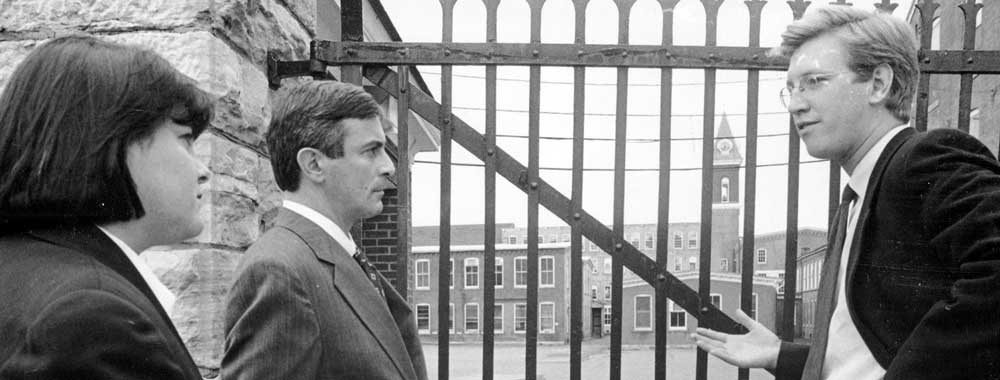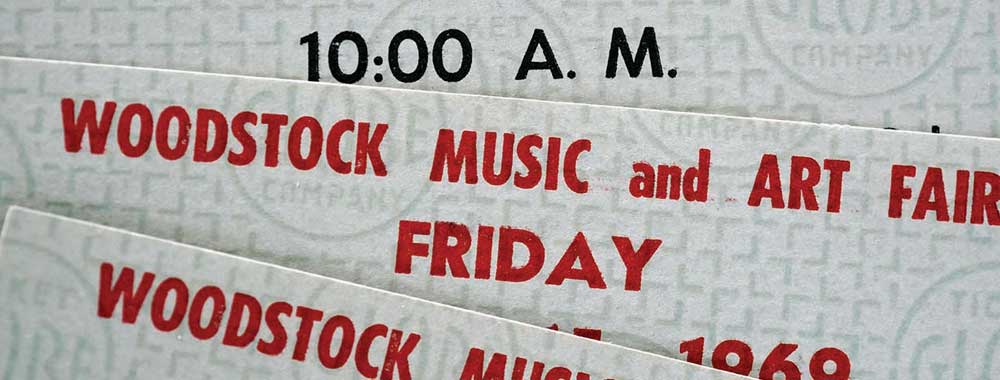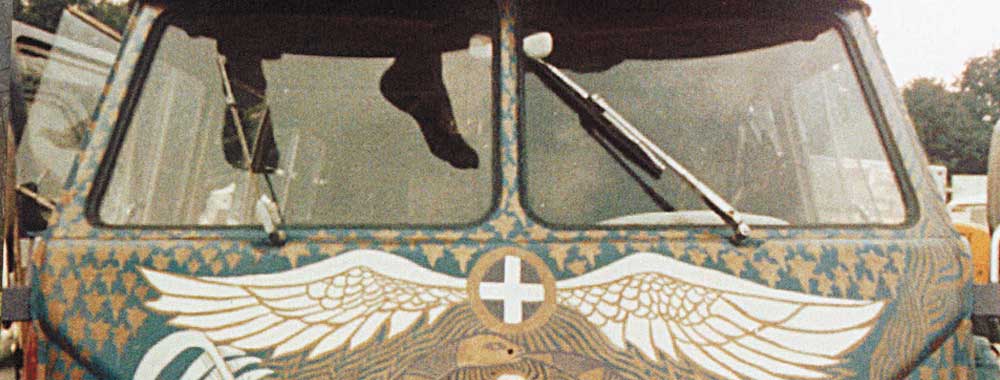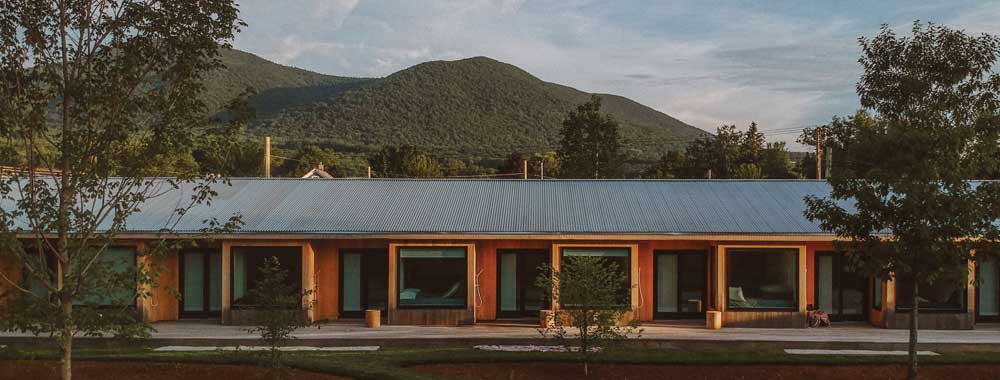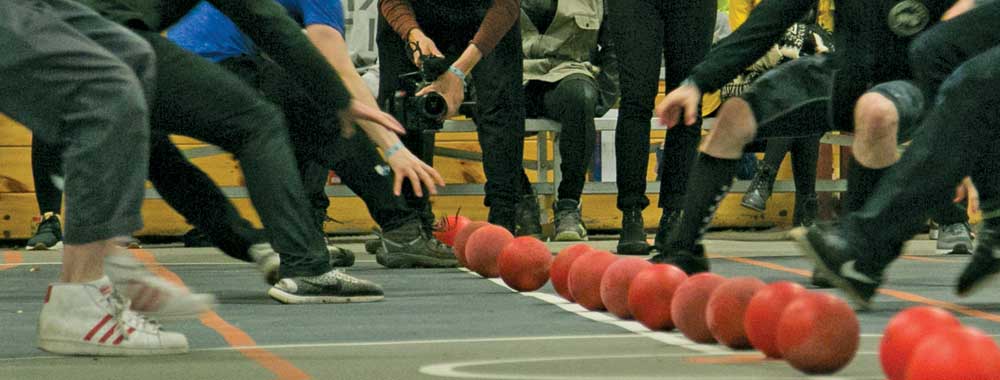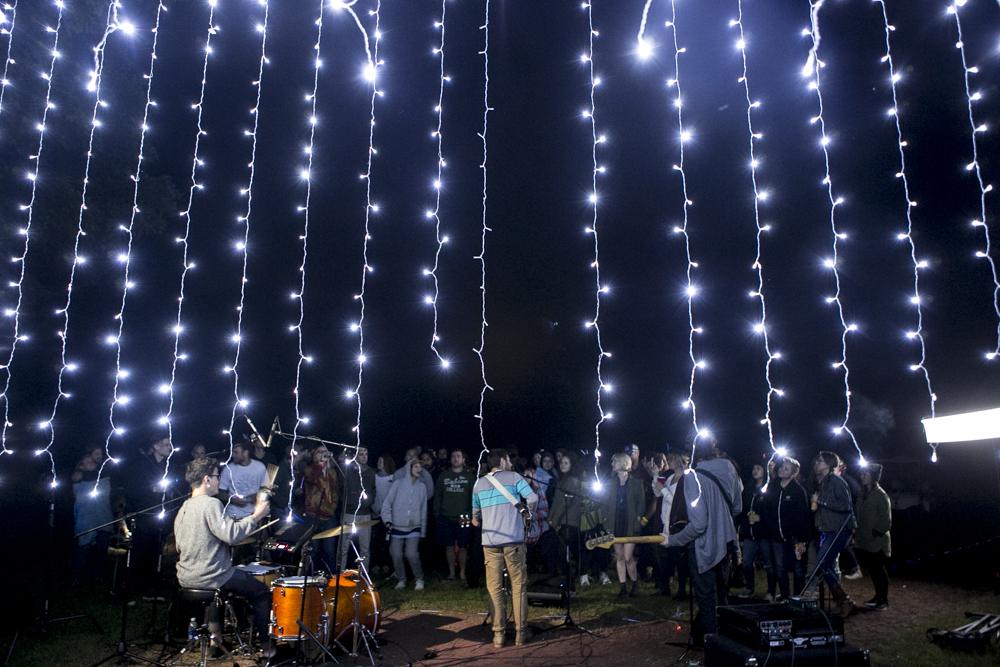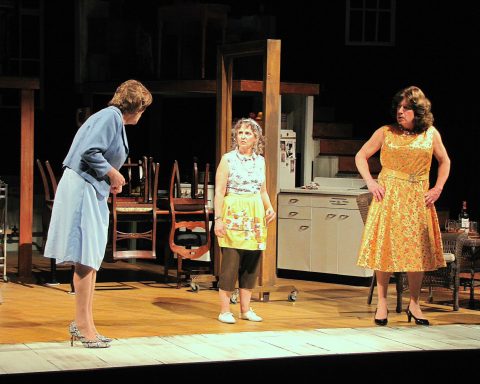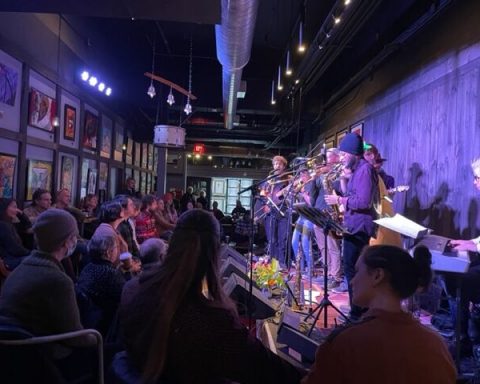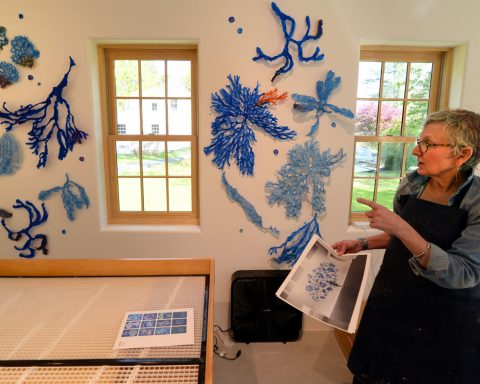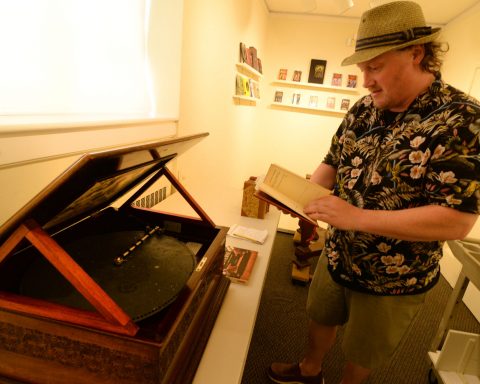
Joseph C. Thompson, director of Mass MoCA, points out the central light well during a tour of Building 6.
By Joseph C. Thompson
With the Massachusetts Museum of Contemporary Art’s 20th anniversary a few weeks away (on May 25, we’ll be celebrating with a free block party, free admission to a full slate of new exhibitions, a benefit concert by Annie Lennox, and a rollicking dance concert with Tank and the Bangas), here are some reflections from the mill.
As we first contemplated Mass MoCA in 1986, I would have never imagined a beer hall and a barbecue joint at our front door, and it couldn’t be more felicitous: picnic tables, red-and-white gingham tablecloths, people hanging out, making music, eating ice cream — all in our front courtyard. Someone once asked whom we should commission to design those tables. I felt the standard model from our local Shed Man would do just fine: Picnic tables are a familiar and universally welcoming signal.
David Byrne once wrote a song for a work of theater he was developing in residence at Mass MoCA, and it says, “God draws straight, but with crooked lines.” I love that lyric. The original idea for Mass MoCA was monumental (but included no barbecue or performing arts). The idea was to use vast, industrial spaces for oversized works of art that required neither perfect climate control nor exquisitely detailed white-walled galleries. This was to be a largely fixed-in-place depot for American minimal art, with spaces resonant of the lofts in which much of that work was originally conceived and fabricated.
That Mass MoCA version 1.0 idea got built, and beautifully, but just not in North Adams. It is called Dia:Beacon and was realized in 2003 by Michael Govan (now director of the Los Angeles County Museum of Art) who, along with me, Zelda Stern and Rod Faulds, comprised the small staff at Williams College Museum of Art, when our boss, Tom Krens, first suggested utilizing empty mill space in North Adams for large-scale sculpture.
Tom’s original and brilliant notion, inspired by his visit to documenta and Schaffhausen (but also influenced by Gehry’s The Temporary Contemporary, in Los Angeles, and the Mattress Factory in Pittsburgh), was to renovate 30,000 square feet of space in a nearby empty mill, on the other side of North Adams.

Mass MoCA Founding Director Joseph Thompson explains the history of the Sprague Electric complex to Lt. Gov. Paul Celucci and state Sen. Jane Swift on May 2, 1992.
When then-mayor of North Adams, John Barrett III caught wind that deep-pocketed Williams College was poking around for adjunct gallery space in his city, he suggested that we look instead at the recently-vacated Sprague Electric Co., which had just announced — in 1986 — that it was shuttering all operations in its 800,000-square-foot, 26-building downtown mill complex. What an utterly absurd idea. But then local attorney John DeRosa informed us that the city had just drafted a community redevelopment plan at the behest of Gov. Michael Dukakis, in which local leaders had decided that putting North Adams on the same Berkshire map of destination cultural attractions that included Tanglewood, The Clark, Williamstown Theater Festival, Williams and Jacob’s Pillow could be a vital element within a comprehensive, postindustrial, redevelopment plan.
In that context, DeRosa thought the governor might be intrigued by this “Berkshire Museum of Contemporary Art.” He proved to be correct. The governor liked the idea, local legislators and community leaders went to work, and we suddenly found ourselves — or so it seemed — the winners of a $35 million state grant for construction. But then everything went to hell in a handbasket. Dukakis lost his presidential bid. The state economy entered a dismal tailspin.
Tom and Michael were off to run the Guggenheim in New York City. And it turned out that the new governor, Bill Weld, was not an immediate fan of the idea “of putting contemporary art, of all things, in North Adams, of all places.”
I stayed behind to try to put Humpty Dumpty back together … during which time the entire program changed. Although the period from 1989-1996 was difficult, and at the time I thought Bill Weld and his administrative chief, Charlie Baker, were the Darths Sidious and Vader, in retrospect, the fact that they sent the project back to the drawing board ultimately saved it. I am perhaps the world’s biggest fan of Dia:Beacon. But I thank our lucky stars that we failed to realize that version 1.0 idea in North Adams because it never would have survived here. (Dia’s quasi-permanent collection is enjoyed by a steady stream of contemporary art-cognoscenti arriving by train direct from midtown Manhattan.)
Three things happened during that desultory period, between 1988 and 1997, as we came to understand its potential as a vast open platform for creating and showing new work in all disciplines, instead of a bunch of big warehouse boxes for minimal sculpture (or to paraphrase another one of our favorite artists, Beck — something more institutionally akin to two turntables and a microphone):
1. Performing arts became absolutely integral to Mass MoCA’s mission.
We now expend a full 50% of Mass MoCA’s financial resources, staff time, and emotional bandwidth on performing arts — from contemporary dance, and multimedia theater, to indie-rock, film, and multiday, multivenue festivals that range from decidedly new music (Bang on a Can), to decidedly traditional (FreshGrass) alongside events that are difficult to even try to describe. We produce many of these right here during extended artist residencies and technical workshops, including a recent work by William Kentridge that brought some 60 South African actors, musicians and designers to the smallest city in Massachusetts for the better part of a month, prepping the show for its premiere at London’s Tate Modern before heading to New York.
2. We diversified our real estate portfolio.
Mass MoCA has become home to some 35 commercial tenants who share space with us on this beautifully recycled 16-acre, 26-building factory campus, bringing jobs and activity (and lots of local real estate taxes!) to North Adams. These businesses bring about $8 million per year in economic activity, which, alongside Mass MoCA’s $42 million per year, means that this complex is the catalyst for some $50 million of economic activity every year. That figure is about twice the original economic impact forecast, by the way, which is a powerful return on the state’s original investment. That said, we know that is not yet enough: there is still much work to do to achieve full socioeconomic recovery in North Adams, as the city continues to navigate the challenging arc from industrial to postindustrial life.
3. We focused on temporary exhibitions.
Instead of showing monumental, fixed-in-place sculpture, we shifted our thinking to focus on temporary exhibitions — most of which feature brand new work, many by midcareer and emerging artists — works that would be almost impossible to realize in space-bound, time-bound urban settings. Taryn Simon’s “A Cold Hole,” in which museum patrons are invited to navigate across an actual ice pond before plunging into a 12-foot-deep chasm of frigid (38 degrees Fahrenheit!) water, is about to make way for works by filmmaker and multimedia artist Cauleen Smith. Trenton Doyle Hancock has just opened a technicolor, character-driven theme-park of an exhibition that explodes his paintings and action-figure narratives into three dimensions. Annie Lennox is about to open a sort of material diary, embedding a large mound of dirt with objects drawn from her private collection of artifacts and personal mementos. It doesn’t all rotate every 10 months, though — Mass
MoCA’s long-term installations of Sol LeWitt, James Turrell, Jenny Holzer, Laurie Anderson and Anselm Kiefer harken back to the original Mass MoCA 1.0 model, complimenting our parade of changing exhibitions with milestone installations of art that stay put for 10, 15, 25 years at a time.
Happily, these programmatic shifts aligned with the more inclusive and nonhierarchical way that people (and especially younger people) absorb art and culture today. A recent study that I think of as the “ice cream museum report” showed that for millennials, going to a museum of ice cream (which is actually an immersive experience based on visual spectacle and Instagrammable moments), or listening to a street musician play beside an ethnic food truck, carries the same sort of cultural weight as visiting a museum of art, or listening to a staged concert. While alarming in parts, that study is also exciting, highlighting the more experiential, porous, inclusionary and open-minded attitudes of younger generations.
When Wilco’s ambitious drummer, Glenn Kotche, creates participatory percussive sculptures to activate our Sol LeWitt galleries, and then returns to write music for an avant-garde dance and theater piece that also happens to feature Jon Hamm, and then returns to play for 10,000 people with Wilco at the band’s sold-out Solid Sound Festival … that sort of cross-cultural mashup speaks volumes to our growing audiences.
As does the beer and barbecue at the front door. Happy 20th, MASS MoCA. •
Joseph C. Thompson is the founding director of Mass MoCA. This column was adapted from a similar column running in the May/June 2019 issue of Art New England.
